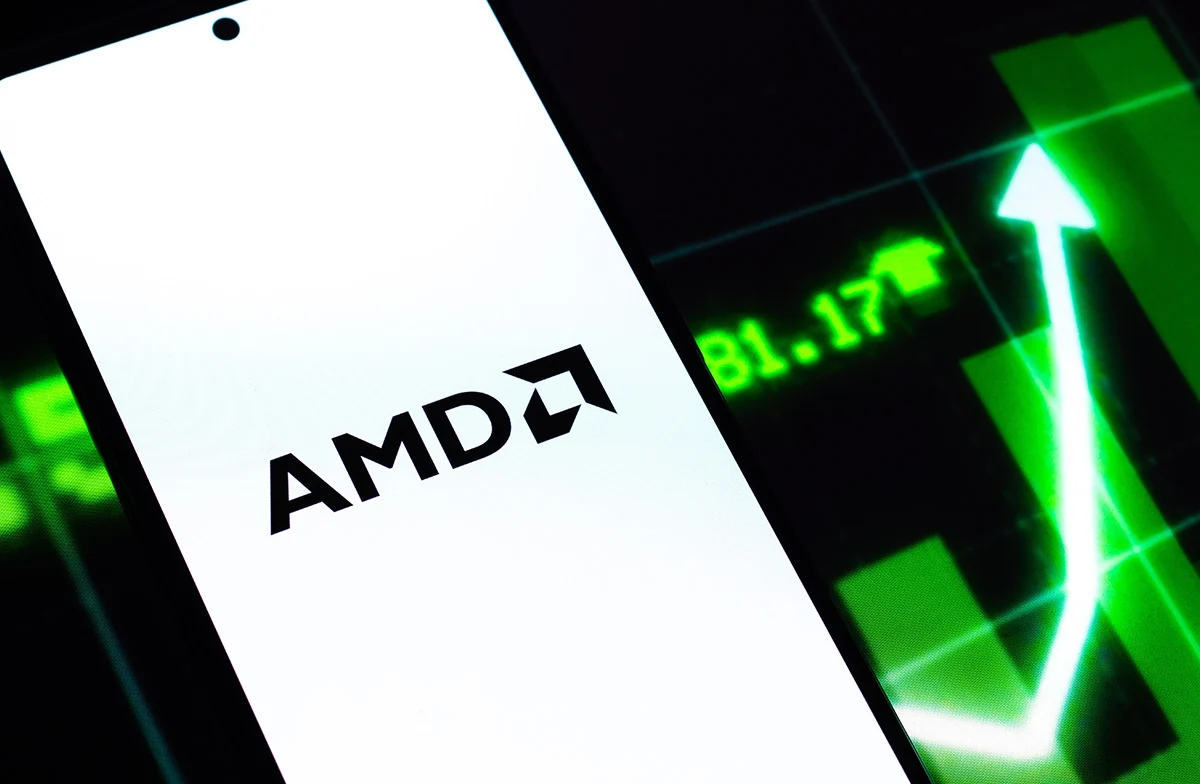AMD Stock Falls Over 5% on Earnings Miss and China AI Chip Uncertainty
Shares of Advanced Micro Devices (AMD) slid more than 5% on Wednesday after the chipmaker’s latest quarterly results came in just shy of analyst expectations and raised new concerns about the timing of AI chip shipments to China.
Earnings Miss
The Santa Clara, California–based company reported adjusted earnings of 48 cents per share for the quarter, missing the 49 cents per share consensus forecast from analysts polled by LSEG.
Revenue guidance for the current quarter came in at $8.7 billion, plus or minus $300 million, ahead of analyst expectations of $8.3 billion. However, the upbeat forecast was tempered by uncertainty around sales to China due to U.S. export restrictions.
Impact of China AI Chip Restrictions
AMD CEO Lisa Su acknowledged on the company’s earnings call that U.S. export controls on artificial intelligence chips have hurt business in China.
“AI business revenue declined year over year as U.S. export restrictions effectively eliminated MI308 sales to China, and we began transitioning to our next generation,” Su said.
The MI308 is AMD’s current AI accelerator chip. The company is developing a version tailored for the Chinese market to comply with U.S. trade rules, but its latest forecast does not include revenue from those sales.
Regulatory Challenges and Market Strategy
In an interview with CNBC’s Squawk on the Street, Su said AMD has been working closely with the U.S. government on licensing requirements needed to resume shipments to China.
“From our standpoint, we think we have an extremely strong portfolio,” she said. “Tens of billions of dollars is the opportunity in a market that’s going to be, let’s call it 500 billion plus over the next few years.”
Su emphasised that the company took a “prudent” approach to its revenue guidance while regulatory uncertainties remain.
Market Context
The AI chip market has been booming, driven by demand for generative AI and large‑scale computing. While AMD has positioned itself as a key competitor to Nvidia, export restrictions have complicated its ability to fully tap into the massive Chinese market — historically a significant buyer of high‑performance chips.
Analysts say AMD’s next‑generation AI products, expected to launch later this year, could help offset lost China sales if adoption accelerates in other regions.
AMD Shares Slide Over 5% After Earnings Miss and China AI Chip Uncertainty
Shares of Advanced Micro Devices (AMD) fell more than 5% on Wednesday after the chipmaker narrowly missed Wall Street’s earnings expectations and flagged continued uncertainty over its ability to ship artificial intelligence (AI) chips to China.
The results come at a critical moment for AMD, which is working to strengthen its position in the fast‑growing AI semiconductor market while navigating U.S. export restrictions aimed at curbing China’s access to advanced computing technologies.
Quarterly Results Fall Short
For the latest quarter, AMD reported:
-
Adjusted earnings: $0.48 per share (vs. $0.49 expected by analysts polled by LSEG)
-
Revenue forecast: $8.7 billion ± $300 million for the current quarter (vs. $8.3 billion expected)
While the revenue guidance topped consensus estimates, the modest earnings miss, combined with regulatory headwinds, weighed on investor sentiment.
U.S. Export Restrictions Hit China AI Business
On the company’s earnings call, AMD CEO Lisa Su said U.S. export rules targeting AI chips had a measurable impact on results.
“AI business revenue declined year over year as U.S. export restrictions effectively eliminated MI308 sales to China, and we began transitioning to our next generation,” Su said.
The MI308 AI accelerator was AMD’s primary product for the Chinese AI market. In response to the restrictions, AMD is developing a compliant version designed to meet U.S. licensing requirements, but Su noted that no revenue from this new chip is included in the current guidance.
Regulatory Uncertainty and Strategic Response
During an interview with CNBC’s Squawk on the Street, Su said the company has been in active discussions with the Biden administration regarding export licenses and compliance requirements.
“From our standpoint, we think we have an extremely strong portfolio,” Su said. “Tens of billions of dollars is the opportunity in a market that’s going to be, let’s call it 500 billion plus over the next few years.”
However, she stressed that AMD is taking a “prudent” approach in its outlook given the ongoing regulatory uncertainties.
The Stakes in the AI Chip Race
The AI chip sector has become one of the most competitive — and politically sensitive — areas in technology. Demand for high‑performance AI accelerators has surged amid the rise of generative AI and large‑scale model training, with Nvidia dominating the market.
AMD has been positioning itself as a strong alternative, launching its MI300X and MI300A accelerators late last year. The company is now pushing to ramp production and expand customer adoption across hyperscale data centers, cloud providers, and enterprise AI workloads.
Analysts Weigh In
Market analysts note that while the China restrictions are a headwind, AMD’s opportunity in the rest of the global AI market remains significant.
Some believe the second half of 2025 could bring a rebound in AI‑related revenue as next‑generation products gain traction. Others caution that AMD will have to work harder to close the gap with Nvidia, which continues to dominate AI chip market share and enjoys first‑mover advantage with its CUDA software ecosystem.
Looking Ahead
Despite the share price drop, AMD remains bullish on long‑term AI growth. The company expects demand for its AI accelerators to expand rapidly as more industries integrate large‑scale machine learning, and as data center operators seek Nvidia alternatives to diversify their supply chains.
The company’s next few quarters will likely be shaped by:
-
Progress in developing and shipping China‑compliant AI chips
-
Ramp‑up of its MI300 series
-
Expansion into enterprise and cloud AI workloads
-
Competitive dynamics with Nvidia, Intel, and emerging AI chip startups
![]()
Share this content:
